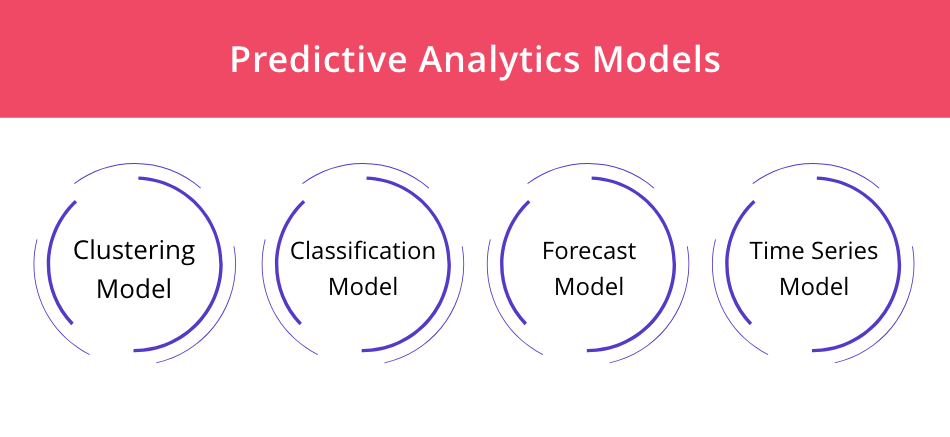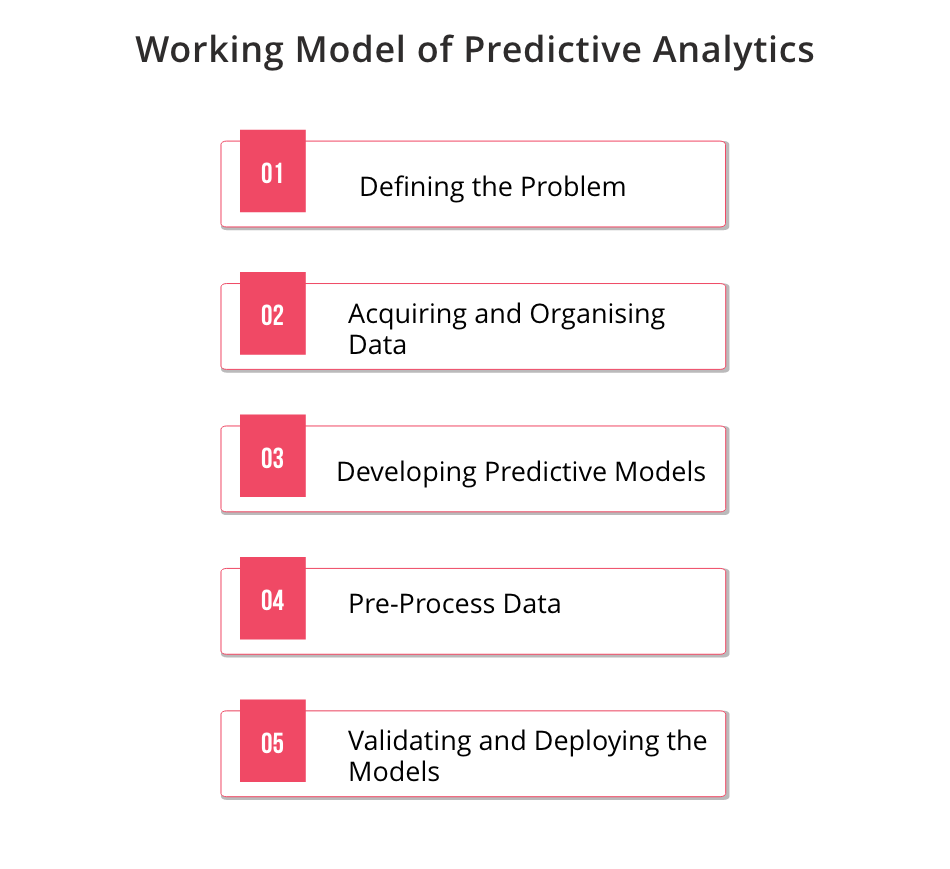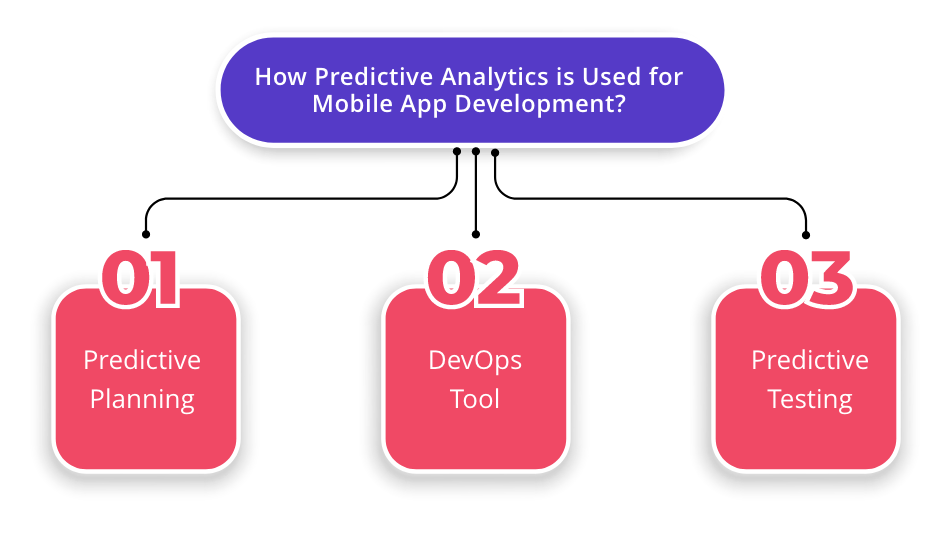Predictive data analytics helps in systematically analyzing large volumes of data to gain a comprehensive understanding of users’ past behaviors.
Updated 4 January 2024

Global Delivery Head at Appventurez
Predictive analytics focuses on making proper predictions of future outcomes. It depends on the historical or current data, analytics techniques like machine learning, and statistical algorithms. With predictive analytics applications, any company can perfectly forecast behaviors and trends in just a fraction of a second.
Predictive data analytics provides businesses with personalized insights into the behavior of the consumer. The service is widely used in finance app development services, healthcare, sales, and marketing, among others. It enables them to accurately anticipate what the consumer wants while also making informed decisions on how to proceed further with their business strategy. With its growing popularity in businesses, predictive analytics is expected to hit USD 28.1 billion by 2026, with a CAGR of 27.1% during 2021-2026.
Predictive analytics applications in businesses help in systematically analyzing large volumes of data to gain a comprehensive understanding of past behaviors. In this blog, we will further explore why predictive analytics has become such a significant tool for modern businesses.
Predictive analytics is a category of data analytics that aims at making predictions about future outcomes. They are based on historical data and analytics techniques such as statistical modeling and machine learning for data analysis. The science of predictive analytics can generate future insights with a significant degree of precision.
With applications of predictive data analytics tools and models in business, any organization can easily use past and current data to reliably forecast trends. Predictive analytics software has also captured the support of a wide range of organizations with a global market size predicted to reach $38 billion in 2028. It is a great way to add more clarity and insight to make proper business decisions.
Predictive data analytics tools are powered by several different models and algorithms that can be applied to a wide range of use cases. Determining what predictive modeling techniques are best for your business is key to getting the most out of the data to make insightful decisions. Check 5 top predictive data analytics models:
It sorts data into separate, nested smart groups based on similar attributes. With the use of the clustering model, businesses can quickly separate customers into similar groups based on common characteristics. It helps in further devising the strategies for each group in large part.
The classification model of predictive analytics puts data in categories based on what it learns from the historical data. This model is best for answering yes or no questions, providing a broad analysis that will be helpful for guiding decisive action.
One of the most widely used predictive analytics models deals in metric value prediction, and estimating numeric for new data based on the learnings from historical data.
It comprises a sequence of data lines while using time as the input parameter. The time series model uses the data of the last year to develop a numerical metric and predicts the next three to six weeks of data with the use of that metric.

Predictive Analytics is a way of creating futuristic predictions, just as meteorologist uses atmospheric data to make weather forecasts. Artificial intelligence, analysis, data, and ML are all components of predictive analytics. The use of predictive data analytics in business begins with a goal, whether that is to cut costs, increase employee retention or save time.
The working model of predictive analytics tools in businesses varies as per the goal and the industry. However, in general, predictive analytics workflow consists of the following steps:
A prediction starts with a good thesis and a set of requirements. For example, can a predictive analysis model detect fraud or identify the potential flood levels from serious weather? A distinct problem to solve will help in determining what method of predictive analytics should be used.
A business may have years of data to draw upon. It is important that the data flows must be identified before the predictive analytics models can be developed.
Data scientists have a variety of tools and techniques for developing predictive models depending on the problem to be solved and the nature of the dataset. Regression models and machine learning are some of the most common types of predictive models.
In order to prepare the data for predictive data analytics models, it should be cleaned to remove anomalies, extreme outliers, or missing data points. They could be the result of input or measurement errors.
Checking on the accuracy of the model and adjusting it accordingly. Once acceptable results are achieved, they should be made available to the stakeholders via website, app, or dashboard.

Predictive analytics can be deployed in various industries for different business problems. Find below a few use cases explaining how predictive data analytics can impact decision-making within real-world situations:
Predictive analytics application in healthcare is used to detect and manage the care of chronically ill patients. With the increased use of healthcare mobile applications, getting access to health records has become much easier. Predictive analytics can be used to mine health records to learn more about how a particular disease was diagnosed, and treated in the past. The method yielded positive results and helped in the treatments of the patients.
Financial services use machine learning and quantitative tools for predicting credit risk and for detecting fraud. Predictive analytics applications allow financial companies to support market changes. It also allows customizing personal services for clients to minimize the risk.
Businesses commonly use predictive analytics for managing product inventory and setting pricing strategies. It helps the companies in meeting customer demands without overstocking the warehouse. It also enables the companies to assess the cost and return on their products over time.
Marketing and sales teams are very familiar with business intelligence reports to understand sales performance. However, predictive analytics enables companies to be more proactive in the way they engage with their clients across the customer lifecycle.
“The purpose of predictive analytics is to turn data into information. It is valuable and applicable from financial services to the aerospace industry— further enhancing customer satisfaction.”
— Ashish Chauhan, Global Delivery Head
Predictive Analytics applications in mobile app development can modify the way the application will work for the targeted consumers. For example, if you have created a game app, the data collected from the game players can help in fine-tuning the app while also informing how often people use it.
The use of predictive analytics for mobile apps is a great way of adding more clarity and insight to make proper business decisions. Below are some of the ways where predictive analysis is used in the development of a mobile application to make it more efficient.
Predictive data analytics can be used in mobile app development to find any repetitive mistakes that might result in various bugs. It also helps in analyzing the total number of code lines that are developed by the developers. The predictive application for analytics offers the details to find whether the businesses can meet the specified delivery date.
Open Source DevOps tool merges mobile app development and operations in order to speed up the delivery time of mobile applications. In case the data of the production gets back to the development team, predictive data analysis for mobile apps will help in finding the coding process that is creating an unpleasant user experience for the consumers.
Apart from testing each and every combination of user interfaces, predictive analytics applications can be used to detect a path that is generally used by the users. Under this, algorithms are used to analyze the common factors between the execution flows of the users and find out an overlapping that usually shows the execution paths that are common.

There are various different ways through which businesses can utilize predictive mobile data analytics applications. It helps in improving the overall experience and effectiveness of the mobile applications. Find some of the points below that further explain the impact of predictive data analytics on mobile app development:
It is a great indication of how many enterprises utilize mobile data analytics to attract customers. With the implementation of predictive analytics in your mobile applications, it is easy to provide users with the ultimate personalized messages and listings. It further makes the whole experience even more customized.
Predictive analysis applications assist in improving user retention to a great extent. It helps businesses get the right picture of how the customers interact with their app and the various ways the consumers are looking to engage with an app. Applications of predictive data analytics in businesses assist in correcting any issues and improving the features that attract customers.
Applying predictive data analytics to mobile applications helps businesses figure out the behavioral patterns of the consumer. The preference for products or services by the consumers assists the entrepreneurs in figuring out the preferences of the consumers. Analyzing the data facilitates businesses in targeting the market more effectively.
Predictive analytics for mobile applications, when perfectly implemented, offer businesses insights into what device the consumers are using while using the app. This data is extremely crucial for the technical team as it will help them in designing the app on the basis of the preference of the target audience.
The application of predictive data analytics in businesses helps in identifying the target consumers through the collected data. Applying predictive data analytics in mobile apps helps in improving business intelligence while identifying the user’s previous searches and history. Find some of the examples below and understand how applying predictive analytics helped the businesses:
With the digital transformation of Netflix, the streaming giant has combined large amounts of user data and preferences such as preferred genres, history, language, etc to offer personalized suggestions to the users. Netflix viewing recommendations are so successful that the brand reports these recommendations to account for over 80% of the content viewers stream.
According to the latest survey, 93% of consumers are satisfied with their voice assistants. One of the most prominent voice assistants in recent times, Siri relies on predictive analytics to cater to its users. The recommendations by the app are usually tailored as per the users’ previous searches and history. Around 81% of the users have expressed satisfaction with the app assistant.
With its various campaigns, Spotify has been able to increase user engagement by applying predictive analytics in its app. One of its major campaigns is the ‘Wrapped Campaign’ in which Spotify grants users a snapshot of their listening habits at the end of the year. By doing so, Spotify provides value to the users in exchange for their data.
Predictive data analytics is an advanced analytics approach that helps in understanding the app’s future and allows to make better decisions. Businesses can make use of predictive analytics to take pre-emptive actions in a wide range of areas.
Applying predictive analytics can result in increased user retention, targeted marketing campaigns, and personalized communication with the users. If your business requires building a mobile app integrated with predictive analytics, Appventurez will be the right choice for you.
Incorporating new data analytics solutions with mobile app development will help businesses make continual enhancements and will also help in app expansion with the latest features. The skilled professionals at Appventurez are adept not only at identifying the target market but also at analyzing consumer behavior within the app. Their expertise extends to leveraging big data application development services, allowing for a comprehensive understanding of user patterns and preferences. This strategic approach ensures a tailored and effective development process that aligns seamlessly with the dynamics of the target market.
Q. How does predictive analytics work?
By applying predictive analytics in mobile applications, businesses can get an insight into the performance of the app. It helps in identifying how the app is engaging with the consumers and brings focus on their future preferences on the basis of accumulated data.
Q. What are some examples of predictive analytics in industries?
Predictive analytics is used by many industries to improve results and anticipate future events to act accordingly. The successful applications of predictive analytics can be found in banking, retail, insurance, and telecommunication, among others.
Q. What are the benefits of predictive analytics?
Predictive analytics empower the organization to optimize operations by predicting the most likely outcomes for the businesses.
Q. What are some challenges in using predictive analytics?
Some of the challenges of using predictive analytics are- collecting the right data, finding the right expertise, facilitating user adoption, and developing a clear strategy, among others.


Elevate your journey and empower your choices with our insightful guidance.

Global Delivery Head at Appventurez
Ashish governs the process of software delivery operations. He ensures the end product attains the highest remarks in qualitative analysis and is streamlined to the clientele’s objectives. He has over a decade of experience as an iOS developer and teams mentorship.
You’re just one step away from turning your idea into a global product.
Everything begins with a simple conversation.